Artists Jeremy Shaw, Fiona Hall and AJ King at MONA
This exhibition at Tasmania’s MONA reminds us how dance classes often require participants to follow instructions barked out by a dominatrix in Lycra.
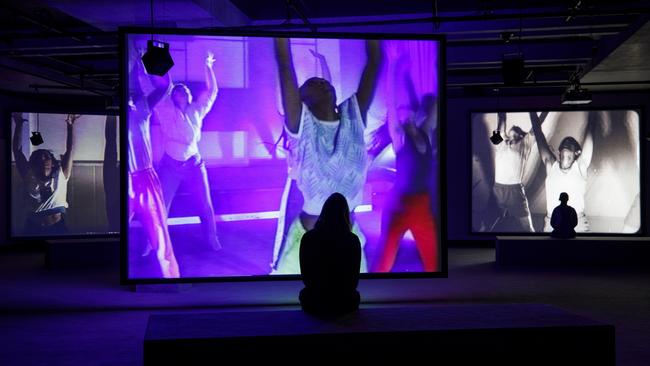
A couple of weeks ago we looked at an exhibition at Hobart’s Museum of Old and New Art that raised some interesting questions about memory, language, ancestry and identity. Another exhibition, concurrently at the same museum, deals with a different order of questions: less specifically connected to the Australian experience but universal in their application in the contemporary world, as one might expect of a Canadian artist and a work previously shown at the Pompidou Centre in Paris.
Jeremy Shaw is an heir to the romantics and the surrealists in his interest in altered states of consciousness, ecstatic experience and the quest for transcendence. And, of course, these aspirations have even older precursors in the long history of mystical and ecstatic traditions within many, if not most, religions.
Mystics always occupy an ambiguous position in established religions. On the one hand they may count among the greatest saints and holy men or women, yet they also can attract suspicion because their style of direct spiritual experience is inherently independent, anti-authoritarian and even anarchic, or at the very least non-institutional.

In ancient Greece the official public religion celebrated in the temples whose remains are visible today was accompanied by the mystery cults whose remains are less apparent but that were an important part of the lives of much of the population. In India, the official practices of Hinduism coexist with the spiritual quests of sannyasis and renunciates. In Islam, the official forms of Sunni and Shia are suspicious of Sufi mystics and dervishes.
Christianity is the most institutionally and doctrinally organised religion in the world, inheriting its centralised and hierarchical administrative structure from the Roman Empire and its systematic theology from Greek philosophy. But mystics have played an important part in its history, too, and even in the development of its doctrines, from the early anchorites to St Bernard of Clairvaux, whose visions helped promote the cult of the Virgin, and St Francis of Assisi, who mystically received the stigmata of Christ.
The Counter-Reformation gave a new impetus to the cults of martyrs and mystics, the latter often depicted as experiencing visions of heaven at the moment of death. The most celebrated of all baroque images of ecstatic experience is Bernini’s statue of St Teresa of Avila, represented swooning in a mixture of pleasure and pain – following her own account in the previous century – as a smiling angel is about to pierce her with the golden arrow of divine love.
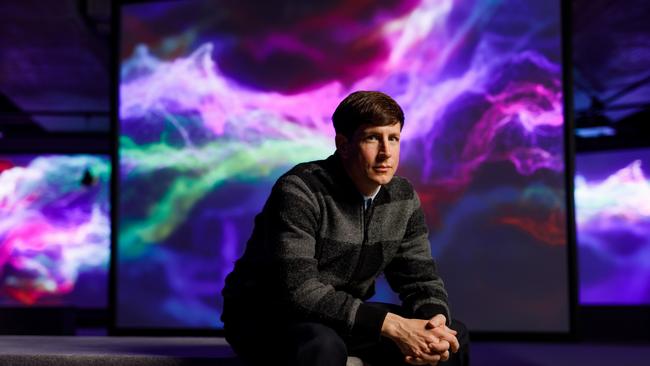
With the decline of religious belief in the past couple of centuries came a rise in ecstatic political behaviour, from the mobs of the French Revolution onwards. In the 20th century, totalitarian leaders became adept at manipulating the crowd and preying on the appeal to weak minds of collective mobilisation. Insignificant people wearing black shirts, or brown shirts or red shirts, marching and screaming slogans together in crowds, experienced the dangerous intoxication of illusory power.
Today, when ever-proliferating identity ideologies have become the opiate of the politically engaged, and new technology allows mobs to gather online rather than in the streets, political mysticism has taken on a different character, more concerned with verbal charades and the suppression of debate than with effective social change. As recent events have reminded us, though, there are still mobs and unpredictable dangers outside, in the world beyond the smartphone screen.
Meanwhile, various other practices have arisen to fill some of the gaps left by the ebbing away of religious belief: yoga, meditation and other forms of non-theistic spirituality are notable examples, but the ones that seem to interest Shaw in particular are things such as the gym and dance classes that have become such a ubiquitous part of middle-class life in wealthy nations.
These may not appear, at first, to have anything to do with spirituality. But as anyone who has been to gym classes knows, they have a natural kinship with fascism – participants eagerly complying with orders barked out by a dominatrix in Lycra – and dance classes designed as a form of exercise are essentially a way of turning off the rational mind and entering into a trancelike state through repeated rhythmic movement.
Shaw’s installation at MONA consists of multiple screens hanging in a large space, each showing some different activity. One is a classic dance class for Barbie lookalikes dressed in coloured jumpsuits. Another is an indeterminate hippie-ish activity in which bodies are manipulated and shaped. Another is modernist dance, going through late 20th-century routines of awkward inarticulacy.
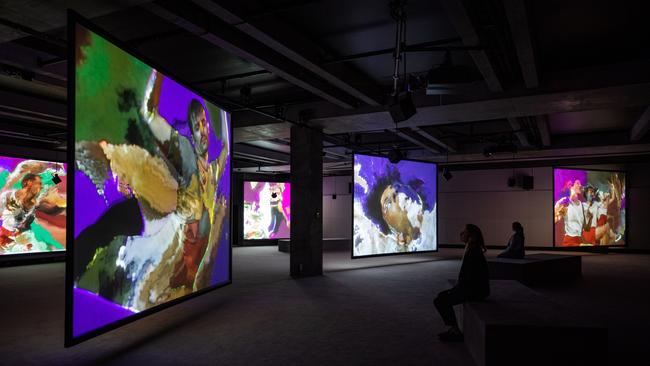
Two of the most interesting are at the back of the room. The first shows a group of people deliberately trying to move like machines, jerky and harsh, rather than fluently like a living body. The other suggests a cult-like activity in which the performers spend all day performing repetitive geometrical marching routines that are meant to produce some kind of cosmic harmony. All of these individual scenes are loosely connected by a familiar sci-fi trope: they are supposed to be set in a near-future dystopia in whose wreckage human beings are trying to find or make meaning.
This scenario is conveyed by the voiceovers that accompany the various films, in a flat and neutral delivery like that of a science or social history documentary from the 1960s. The two episodes just mentioned are accompanied by elaborate but incoherent pseudoscientific explanations of the activities.
The films are subtitled, too, but the subtitles don’t always match the voiceover, which produces a surprisingly disconcerting effect. When individuals in the films speak, what they say is not only disconnected and logically impossible to follow but even partly unintelligible, which in turn contributes to the sense of alienation and even derangement.
Initially the films are distinct, but as the work progresses they gradually merge: first a common soundtrack takes over, increasingly loud and dominating, then suddenly we realise all the performers on the different screens have begun to follow the same choreography: an insistent, repetitive, ecstatic dance sequence to the pounding music. All of these individuals, their specific personalities as well as their particular obsessive routines forgotten, merge into one mass of unconscious humanity.
The effect of ecstatic dissociation and loss of identity is evoked in the next sequence as the figures of the dancers begin to waver, then to break up. Features melt as they do in schlock horror films, and gradually even the mass of humanity produced when all the bodies started to perform the same routine is dissolved into swirls of colour that no longer have any human character.
Finally, the frenetic movement ceases, the swirls of colour disappear, and the screens switch to a mere tangle of disembodied lines, like static. Is this the final vision at the end of the ecstatic process? Or is it all that is left when we die? It certainly has little in common with the vision of a “multifoliate rose” of which TS Eliot writes, recalling Dante. Perhaps this is a picture of the world without consciousness, what the cosmos would look like if mind did not exist.
Appropriately enough, it is another vision of a wasteland that greets us when we walk to the back of this installation and pass through a curtain into a further room. Here we find ourselves in a long dark space, surrounded by the charred stumps and logs of great trees, set on low banks of earth or sand. A path winds through this burnt forest to a hut in the distance.
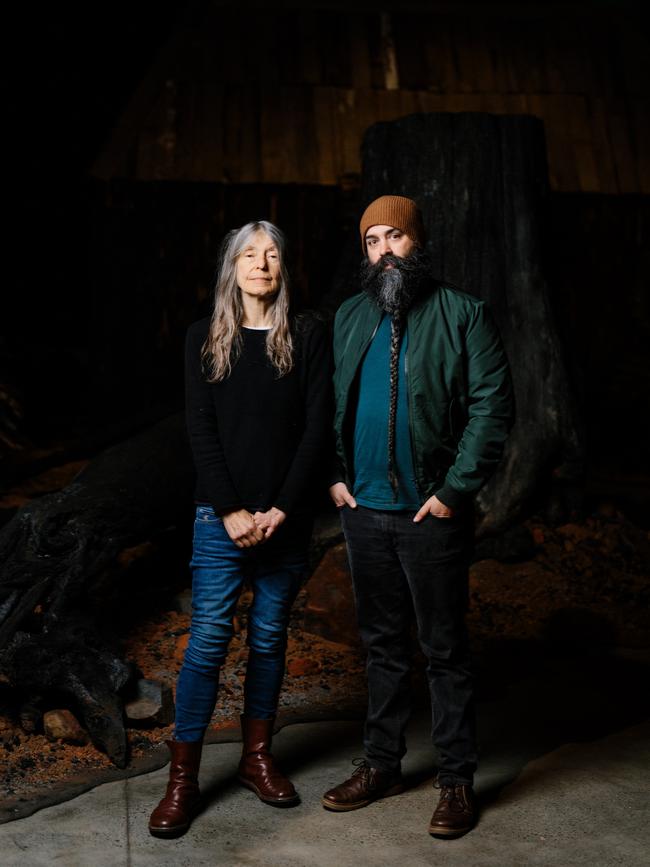
This is a collaborative work by Fiona Hall, born in Sydney and now living in Hobart, and AJ King, who is descended from two Queensland Aboriginal tribes. The project began last year with the re-creation of a cremation hut based on a description left by the d’Entrecasteaux expedition at Recherche Bay, where they camped for more than three weeks in 1792.
The project then developed into something different: reconstructing a settler’s log cabin and charring it inside and out, matching the burnt and devastated landscape all around.
The work clearly recalls the disastrous bushfires that Australia endured in the summer of 2019-20, just before the beginning of the long Covid episode and then the drenching rains of the La Nina cycle of the past two years. Both of these events have conspired to make the fires a distant memory, but anyone who knows the Australian environment understands that another devastating fire season is not only possible but inevitable.
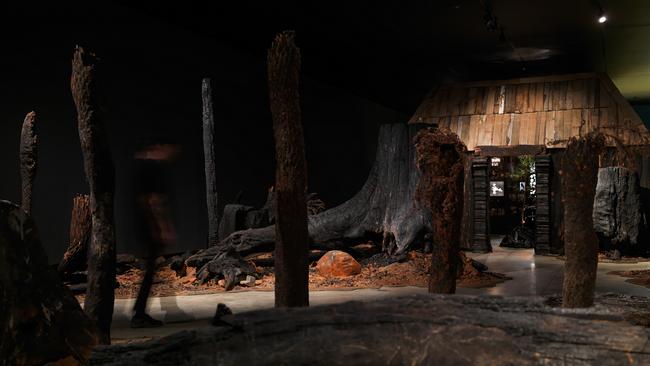
Today, of course, the extreme weather that has always beset our continent is made even worse and more unpredictable by climate change, so the burnt cabin serves as a reminder of human responsibility. Beyond such obvious meanings, however, the cabin in the burnt forest is a powerful poetic image of loneliness and desolation; the most memorable view of the installation is of the cabin in the distance, surrounded and framed by the burnt forest.
Inside the cabin are numerous other objects and motifs, including a cradle and a rope ladder, suggesting both life – the birth of children in the cabin – and the sad possibility of early death. From this inside perspective, the cabin becomes something more like a chapel, an assimilation that is implied in the solemn sense of life and death, and made explicit by the inclusion of a vernacular version of a stained-glass window.
The window’s ogival shape makes the ecclesiastical reference unmistakeable, even if it is composed of plastic bottles. Hall has used light blue, white and violet bottles for the background, and darker blue, brown and green for the inscription, which reads XODUST, a graphic abbreviation of the exhibition’s title.
This title is inspired, of course, by the second book of the Old Testament, which Hall has punningly combined with the word dust, recalling the formulation of the traditional funeral ceremony, “dust to dust”. Many other objects in the cabin evoke death and the destruction of nature, particularly the aluminium sculptures bursting out of sardine cans that recall some of her most memorable early work.
These new sculptures are more elaborate but less subtle in their unambiguous reference to the destruction of the natural environment. But the overall effect of the installation, though dark and sobering, especially at first sight, is not entirely pessimistic: the burnt forest is not silent but animated by recordings of voices and storytelling.
The chapel-like interior of the cabin is also both funereal and luminous, at least in its glass window. And the title of the exhibition, despite the grim pun, recalls the story of Moses leading the people of Israel out of their captivity in Egypt, so perhaps it leaves open the hope at least of a more auspicious future.
Jeremy Shaw: Phase Shifting Index; Fiona Hall and AJ King: Exodust – Crying Country. Museum of Old and New Art, Hobart, until October 17.




To join the conversation, please log in. Don't have an account? Register
Join the conversation, you are commenting as Logout